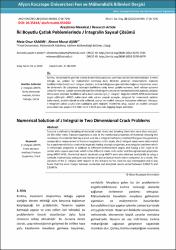İki boyutlu çatlak poblemlerinde j integralin sayısal çözümü
Citation
Kaman, M. O. & Aşan, A. M. (2020). İki Boyutlu Çatlak Poblemlerinde j İntegralin Sayısal Çözümü . Afyon Kocatepe Üniversitesi Fen Ve Mühendislik Bilimleri Dergisi , 20 (4) , 718-729 . DOI: 10.35414/akufemubid.654052Abstract
Kırılma, malzemelerin gerilme altında birden fazla parçalara ayrılması olarak tanımlanmaktadır. Kırılma tokluğu ise, çatlaklı bir malzemenin kırılmaya karşı direncini gösteren malzemelerin mekanik özelliklerinden biridir ve J−integral yöntemi, kırılma tokluğunun geometriden bağımsız ölçümünü veren bir yöntemdir. Bu çalışmada, izotropik özelliklere sahip kenar çatlaklı numune, farklı takviye açılarına sahip 45o merkez çatlaklı ortotropik özellikte dikdörtgen numune ve merkezinde farklı açılarda çatlaklar ihtiva eden izotropik özelliklere sahip kare numune için, J−integral’i değerleri ANSYS APDL kullanılarak tespit edilmiştir. ANSYS kullanılarak elde edilen sayısal sonuçlar, simgesel bir matematik yazılımı kullanılarak, analitik olarak ta elde edilerek, sayısal ve analitik sonuçlar mukayese edilmiştir. Sonuçta; J−integralin çatlak ucuna olan uzaklığına göre değişimi incelenmiş olup, sayısal ve analitik sonuçlar arasındaki hata payının % 0.0462 ile % 2.8149 arasında değiştiği tespit edilmiştir. Fracture is defined as breaking of materials under stress and breaking them into more than one part. On the other hand, fracture toughness is one of the mechanical properties of materials showing the resistance of a material that has a crack and the J−integral method is a method that gives the geometry independent measurement of fracture toughness. In this study, the J−integral values were determined for a specimen which is a crack in its edge and having isotropic properties, a rectangular specimen which is orthotropic properties in addition to different reinforcement angles and having a 45o crack in its center and a square specimen which is the different cracks in its center and having isotropic properties using ANSYS APDL. Numerical results obtained using ANSYS were also obtained analytically by using a symbolic mathematics software and numerical and analytical results were compared. As a result; The variation of the J− integral with respect to the distance to the crack tip was investigated and it was found that the error margin between numerical and analytical results varied between 0.0462 % and 2.8149 %.
Source
Afyon Kocatepe Üniversitesi Fen Ve Mühendislik Bilimleri DergisiVolume
20Issue
4URI
https://dergipark.org.tr/tr/download/article-file/869968https://doi.org/10.35414/akufemubid.654052
https://hdl.handle.net/11630/9642
Collections
- Cilt 20 : Sayı 4 [19]



















